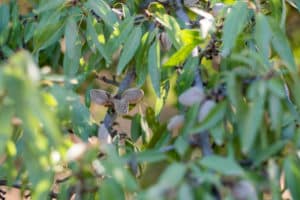By Dylan Rogers, Sales Account Manager
Postharvest irrigation and fertility can be the most crucial aspect of growing trees and vines. Growers, PCAs, and CCAs are always striving to increase yields and quality. Having a solid postharvest game plan plays a critical role in ensuring better yields and quality for next season’s crop.
Postharvest Fertility for Trees and Vines
After the stress of harvest, nitrogen, phosphorous, and potassium will begin to transition from leaves to spurs in almonds, and from leaves to roots and woody tissues in vines. In almonds, bud initiation and differentiation has already begun. Water stress at this point in time will significantly reduce next year’s crop.
Postharvest irrigation for trees and vines is also very important to ensure that the leaves stay active for as long as possible so they can continue photosynthesizing and storing much needed carbohydrates for next year’s crop. When dormancy breaks in early spring, trees and vines will be functioning solely on stored nutrients. Nutrient uptake from the soil is very minimal at this point due to cool soil temperatures as well as the lack of leaves.
Adequate postharvest fertility to replenish nutrient reserves will ensure that your crop has the energy it needs to maximize production when dormancy breaks come spring. Here’s how each of these nutrients plays a role in postharvest fertility for trees and vines.
Nitrogen (N)
Up to 20% of the total seasonal demand for nitrogen in almonds can be applied postharvest. This is also very similar for grapes. Postharvest nitrogen will help maintain leaf area and extend the time for photosynthesis to keep producing carbohydrates in the trees and vines. Postharvest N will also ensure that reserves are replenished and early shoot growth and leaf out will be strong in the spring. It is important to take in-season tissue samples into consideration when determining how much nitrogen to apply. Any soil-applied nitrogen in the nitrate form that is not taken up by the roots will be subject to leaching from rainfall and irrigations. Foliar-applied nitrogen is also a good choice for postharvest applications. It is common to use a fast acting nitrogen source in this situation, such as urea-based products.
 Phosphorous (P)
Phosphorous (P)
The amount of phosphorous used by trees and vines is much less compared to the demand for nitrogen and potassium. However, this does not mean it is less important for optimal growth and yields. A postharvest application of phosphorous will promote healthy fall and spring root flushes, as well as ensure the trees and vines have a good energy source when dormancy breaks in the spring. Choosing a phosphorous fertilizer that is protected from tie up from cations in the soil is important and will ensure that it is free and available for the plant to uptake as needed.
Potassium (K)
Potassium demand in almonds and grapes is even higher than that of nitrogen. A postharvest application of potassium is essential in order to restore reserves, even more so if your yields were above average this season. Potassium is an important aspect in plant water relations and cell reproduction. If potassium reserves are deficient when dormancy breaks in the spring, new fruiting spurs will develop at a slower pace or even die prematurely as compared to a tree that has optimal potassium reserves. Root uptake is minimal at this point, so a soil application of potassium will serve to replenish K reserves in the soil. A postharvest foliar application of potassium is a great way to ensure you get the potassium into the trees and vines to replenish those reserves. Choosing a K product that is free of chlorides and hydroxides, as well as effective at penetrating the leaf cuticle and easily translocated once in the leaf will provide the greatest return on your fertilizer investment.
Zinc (Zn)
Zinc is a very important micronutrient that plays a major role in synthesizing auxins. These auxins ensure a uniform bud break and a good fruit set in the spring. Almonds are commonly zinc deficient. This is due to a number of reasons, including certain rootstocks that are not adequate at taking up zinc from the soil. Zinc deficiencies are also common in areas with alkaline soils. Zinc is fairly immobile in the soil so postharvest foliar applications are most effective at correcting deficiencies and restoring reserves.
Boron (B)
Collecting hull samples to send off for boron analysis should be a staple in your postharvest game plan. Hull samples are the most effective indicator of boron levels in almonds. Boron is very critical for development of flowers, specifically pollen development and viability. If the hull analysis shows less than 80 parts per million boron, the trees are deficient and are most likely losing yield potential. Postharvest foliar applications of boron are an effective way to correct deficiencies and restore boron levels in the tree.
As you complete this year’s harvest, let your mind shift gears and begin thinking about next year’s crop. Its fate is already underway and having a solid postharvest irrigation and fertility game plan will ensure your trees and vines go into dormancy with adequate nutrient reserves. With a good postharvest fertility program for trees and vines, your crop will be off to a great start come spring and you’ll be well on your way to improving yields and quality year after year.
Find a crop nutrition expert in your area to discuss your program.


 Phosphorous (P)
Phosphorous (P)